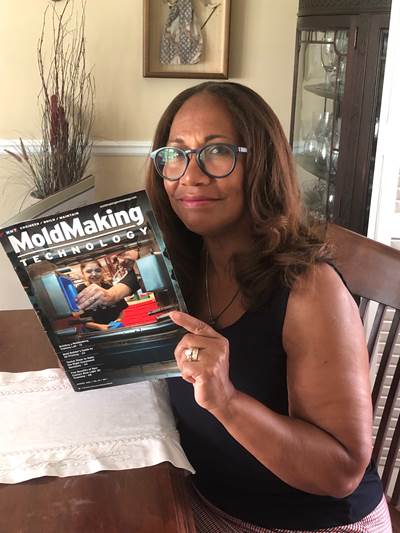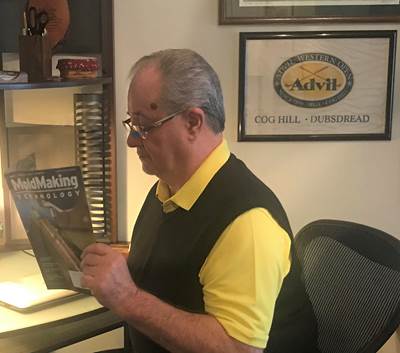Share
Read Next

SyBridge Technologies’ Brian Dippel, operations manager, looks through MoldMaking Technology at work. Photo Credit: SyBridge Technologies
Brian Dippel brings 36 years of plastics and moldmaking experience to MoldMaking Technology's Editorial Advisory Board (EAB). His career has helped him develop an expertise in mold design, construction, production and maintenance. As the operations manager for SyBridge Technologies (formerly X-Cell Tool and Mold), he manages the engineering, quality, program management and molding departments.
Here, he continues this year's EAB series by sharing his three all-time favorite MoldMaking Technology articles and how this content has been valuable to his work and career.
1. January 2020 – How to Become a Better-Informed Mold Purchaser
Six questions every purchasing manager must answer to improve his or her buying skills and create more value for the company.
This article (by fellow board member, James Jergens) caught my attention because I have worked with many customers to keep their molds in optimal condition for peak production performance, so communicating with them about technical issues, cost and delivery is critical. Remember that most moldmakers have not attended college and a conference table is nothing like a workbench. Therefore, someone equally capable of working on the bench or in a conference room is valuable in this line of work.
In my opinion, a person with the unique ability to bridge the gap and communicate the technical, design and cost aspects of tooling with a purchasing-, quality- and budget-conscious owner/buyer is a rare breed. I have worked on mold builds from both ends of this spectrum and when the mold builder and mold buyer are cut from the same cloth, the process is simple, headache-free and a pleasure.
2. April 2010 – Getting Up to Spec
Steps to follow for discovering needed information about inherited tooling.
The title of this article is just the tip of the iceberg, and in the grand scheme of things, can be the easiest part of the job. I read this article years ago and recently, it brought back memories of managing program transfers from other molders into our facility. I always cringed when I had to transfer old tools and equipment that had been in production for years at another company’s facility.
These types of program transfers and experiences helped me develop my program management and people skills. So, I look back at all the work necessary to transfer a program to get it qualified and running, just as the article describes, because that is the job, right? But, in my opinion, there is much more to the process! To this day, I still remember sitting at those conference tables with those people and how that experience has humbled me and shaped my approach to people in my career.
3. June 2020 – 3 Simple Strategies of Scientific Injection Molding
Enhance part design, mold design and processing conditions by using the inputs from scientific injection molding in three easy steps.
This article discusses using scientific injection molding (SIM) processes to improve molding conditions. In addition, the article mentions that “With a little extra technology, analysis and cost upfront, a manufacturer can save money in the long run.” I completely agree with this statement.
You can use SIMs to develop your centerline process for new tools. For example, when you sample a mold for the first time, you need to know how much injection pressure you should use, how much hold time you use and how fast you inject the plastic. With a new mold, an experienced processor can get you started with conservative set points, so you will not damage the tool with your first few shots. Then, once the mold is running, you can adjust parameters based on how the part looks and get good visual parts.
However, how do you know for sure that these set points are optimal for the machine, mold or part quality? This is where SIM comes into play. You can use SIM to finely tune each process parameter to help you develop that centerline process with a good process window for a production environment. I want more content on SIM, Design of Experiments (DoE) and how to use these test methods to develop your production process set point ± limits.
Related Content
Editorial Advisory Board 2023-2026: Meet New Board Member Jenny Kotulak, Integrity Tool and Mold
The 2023-2026 version of MoldMaking Technology’s EAB features a new crew of industry professionals. Meet Jenny Kotulak.
Read MoreHow to Use Strategic Planning Tools, Data to Manage the Human Side of Business
Q&A with Marion Wells, MMT EAB member and founder of Human Asset Management.
Read MoreEditorial Advisory Board 2023-2026: Meet New Board Member Adam Nartker, Diversified Technologies International
The 2023-2026 version of MoldMaking Technology’s EAB features a new crew of industry professionals. Meet Adam Nartker.
Read MoreEditorial Advisory Board 2023-2026: Meet New Board Member Isaac Trevino, Best Tool & Engineering
The 2023-2026 version of MoldMaking Technology’s EAB features a new crew of industry professionals. Here’s one of them.
Read MoreRead Next
Human Asset Management Talent Development Consultant and Partner Shares Three Favorite Articles: Profiles, People, Purpose
MMT's Editorial Advisory Board shares its top MoldMaking Technology articles of all time and how this content has been valuable to their businesses.
Read MoreScholle IPN NA Tooling Manager Shares Three Favorite Articles: Community, Game-Changers and Training
MMT's Editorial Advisory Board shares its top MoldMaking Technology articles of all time and how this content has been valuable to their businesses.
Read MoreReasons to Use Fiber Lasers for Mold Cleaning
Fiber lasers offer a simplicity, speed, control and portability, minimizing mold cleaning risks.
Read More




















